

How to Identify Spruce Trees: 6 steps. Edit Article Distinguishing Spruces From Pines or FirsSpruce Trees Native to the United States Edited by Mr.
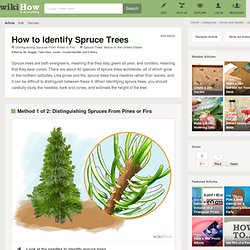
Leaf - Venation - Veins, Parallel, Pattern, and Leaves. Types of Venations for Trees. Monocots vs. Dicots. Having taught in introductory botany for more than five years, I have fielded many questions from students, and present below some of the more common questions and misconceptions.

Thanks go to my students for taking an active role in their own education, and asking these questions Q: Are pine trees monocots or dicots? A: Pines are conifers, and are neither monocots nor dicots. Only flowering plants are considered to be members of these two classes. This question is similar to asking whether a chicken is a monocot or a dicot; it is neither. Q: Do all dicots produce flowers? A: Yes, sort of. There are also some flowering plants which flower only rarely. Q: If monocots don't have wood, then what supports palm trees? A: Palms rely on overlapping leaf bases, thickened enlarged cells, and prop roots to stay up.
Identification of Spruce Trees. Overview The spruce is a species of evergreen coniferous tree that grows primarily in the colder regions of the Northern Hemisphere.
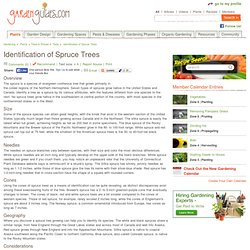
Seven types of spruces grow native in the United States and Canada. Identify a tree as a spruce by its various attributes, with the features different from one species to the next. No spruce trees grow native in the southeastern or central portion of the country, with most species in the northernmost states or in the West. Size Some of the spruce species can attain great heights, with the kinds that exist in the western section of the United States typically much larger than those growing across Canada and in the Northeast. Needles The needles on spruce branches vary between species, with their size and color the most obvious differences. Cones. Types of Roots. Treeglossary. Basic Forest Tree Biology. Trees with opposite leaves « Sibley Guides. Posted October 3rd, 2009; last edited October 3rd, 2009 –– David Sibley In the past, tree identification guides have emphasized the presence of opposite leaves as one of the most important field marks.
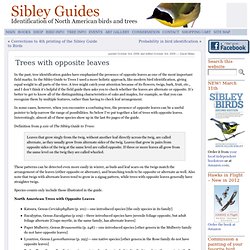
In the Sibley Guide to Trees I used a more holistic approach, like modern bird identification, giving equal weight to all parts of the tree. A tree might catch your attention because of its flowers, twigs, bark, fruit, etc., and I don’t think it’s helpful if the field guide then asks you to check whether the leaves are alternate or opposite. It’s better to get to know all of the distinguishing characteristics of oaks and maples, for example, so that you can recognize them by multiple features, rather than having to check leaf arrangement. ISU Forestry Extension - Tree Biology: Tree Anatomy 101 - START. FOR-61: Scientific Classification of Trees: An Introduction for Wood Workers. Online Publications James E.

Reeb, Extension Specialist, Department of Forestry Introduction Those who work with wood should be able to distinguish between different woods and be familiar with features that make different kinds of wood react differently to cutting, surfacing, finishing, etc. An obvious first step in accomplishing these tasks is to be able to properly identify and name an unknown wood. This publication will introduce the reader to the science of taxonomy, that is, the practice of classifying and assigning living things to groups based on their similarities in anatomical structures. The users of wood should be familiar with the fact that common names can often be misleading and that the wood of some trees with similar common names may actually be quite different in their structures and properties. Common Names Often Misleading Most probably, each kind of tree in the United States has more than one common name.
Monocots vs. Dicots. Tree Identification Using a Tree Leaf Key - Name a Tree by Studying its Leaf. Tree ID - U.P. Michigan. Www.ca.uky.edu/kywoodlandsmagazine/VOL_2_NO_1/Page12forestry.pdf. Idintro. Welcome to the Friesner Herbarium, Butler University Tree Identification Site.
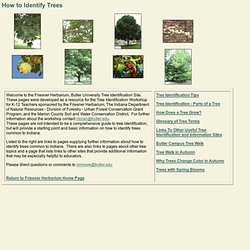
These pages were developed as a resource for the Tree Identification Workshop for K-12 Teachers sponsored by the Friesner Herbarium, The Indiana Department of Natural Resources - Division of Forestry - Urban Forest Conservation Grant Program, and the Marion County Soil and Water Conservation District. For further information about the workshop contact rdolan@butler.edu. These pages are not intended to be a comprehensive guide to tree identification, but will provide a starting point and basic information on how to identify trees common to Indiana. Listed to the right are links to pages supplying further information about how to identify trees common to Indiana. There are also links to pages about other tree topics and a page that lists links to other sites that provide additional information that may be especially helpful to educators.
Please direct questions or comments to mmoore@butler.edu. Familiar Trees - Description of Terms. Terminology - Leaf, Twig, and Fruit Characteristics Used in Tree Identification Familiarization with the following diagrams and terms will make the leaf key and tree descriptions easier to understand and use.
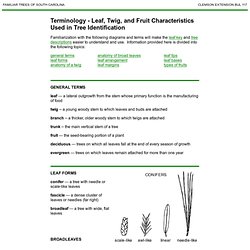
Information provided here is divided into the following topics: conifer — a tree with needle or scale-like leaves. Click here to ENTER.